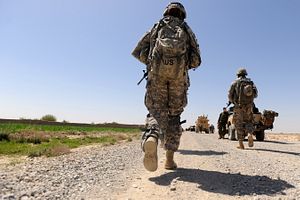Al-Qaeda is ostensibly the reason the United States got involved militarily in Afghanistan more than a decade ago. But as the war in Afghanistan progressed, al-Qaeda receded as a target and seemingly as an active player. When Osama bin Laden was killed in 2011 in neighboring Pakistan, the group seemed to be at a nadir. But this week, acting Afghan Defense Minister Masoom Stanekzai told CNN that al-Qaeda was resurgent.
“They are really very active. They are working in quiet and reorganizing themselves and preparing themselves for bigger attacks…They are working behind other networks, giving them support and the experience they had in different places. And double their resources and recruitment and other things,” Stanekzai said. “[T]hey are not talking too much. They are not making press statements. It is a big threat.”
TOLOnews reported earlier this month on a recent NATO assessment that militant groups were active in 20 provinces. The map included showed dots indicating Taliban activity in 15 provinces, al-Qaeda activity in five, and ISIS (Daesh on the map) in two (obviously, some provinces have multiple groups active within them). The concentration of al-Qaeda activity is along the eastern border–Paktia, Paktika, Khost, Nuristan, and Kunar–where “militants who are apparently associated with al-Qaeda are looking to establish military camps.”
Major General Jeff Buchanan, the deputy chief of staff for operations in Afghanistan, agreed with Stanekzai. He told CNN that intel assessments from as recently as last year pegged al-Qaeda numbers at 50-100, “but in this one camp we found more than 150.”
“There’s not thousands of them,” he said, “but clearly in remote parts of Afghanistan there are al Qaeda leaders we’re concerned about and what they’re capable of doing.”
Last October, the United States raided and destroyed a pair of al-Qaeda training camps in Kandahar. General John F. Campbell, who led the NATO’s Resolute Support mission until early March, told the Washington Post after the raid, “This was really AQIS, and probably the largest training camp-type facility that we have seen in 14 years of war.”
Bill Roggio and Thomas Joscelyn commented in the Long War Journal at the time: “The U.S. military has not answered an obvious question: How did al-Qaeda establish two training camps along the Afghan-Pakistan border in a province that is supposedly secure from the Taliban?”
Afghanistan has no shortage of militant groups, but some get more media-time than others–which warps general perceptions. There’s also history to complicate matters. The Taliban sheltered al-Qaeda as it planned and executed the 9/11 attacks, but when the United States invaded it not only crushed al-Qaeda but swept the Taliban from power. While the old guard still lived, the assumption was that the two groups were no longer close. CNN put it like this, “The Afghan militant group was thought to have regretted its decision to harbor Osama bin Laden before the September 11, 2001 terrorist attacks, because it led the U.S. to launch a war to remove them from power.”
But following the death of bin Laden in 2011 and the revelation last year that Mullah Omar had died in 2013, ties improved. In August, it was reported that Mullah Mansour, the new Taliban leader, had accepted an oath of allegiance from bin Laden’s deputy, Ayman Zawahiri, who had assumed control of the network after his death.
Comments made by Campbell last October ring true, still: “What I think you have to do is challenge your assumptions here… Things change, and what was good here in 2010 or 2011 may not necessarily be good today as far as the enemy.”

































